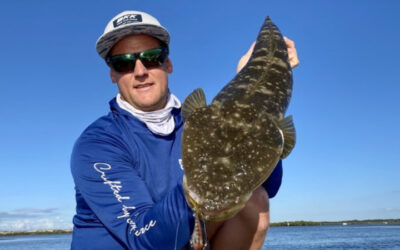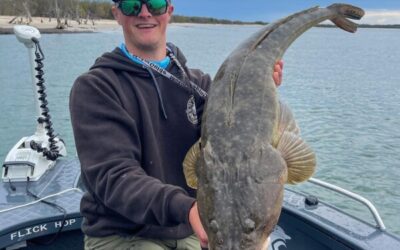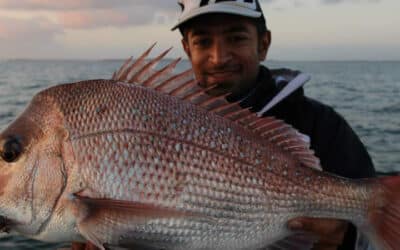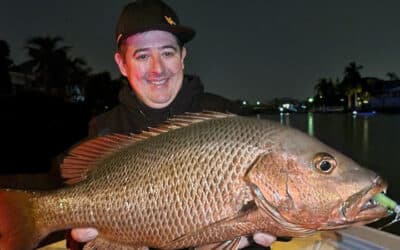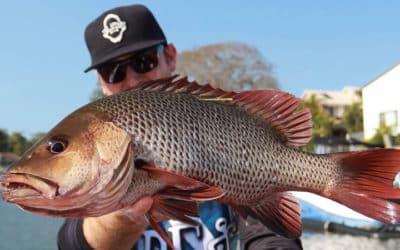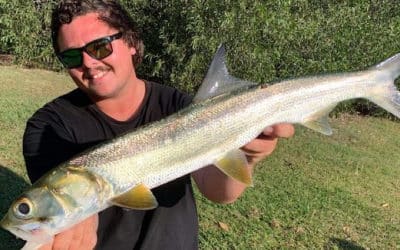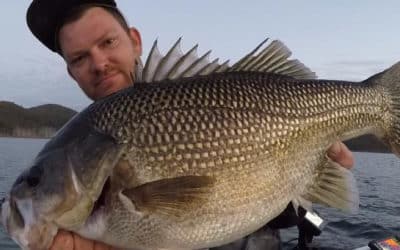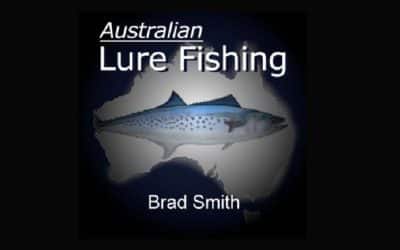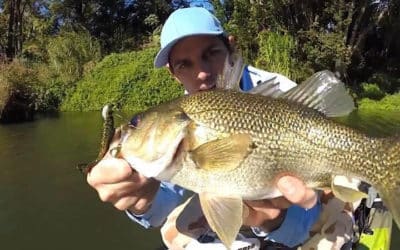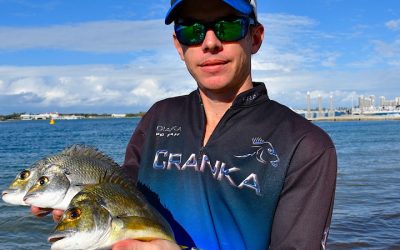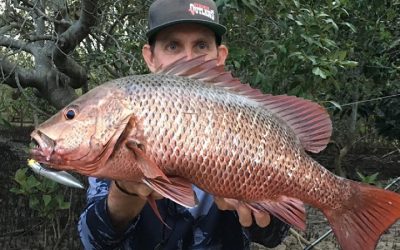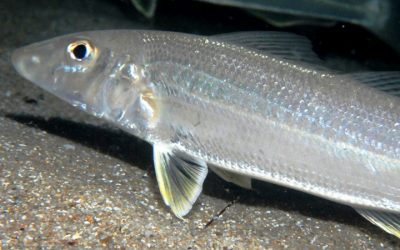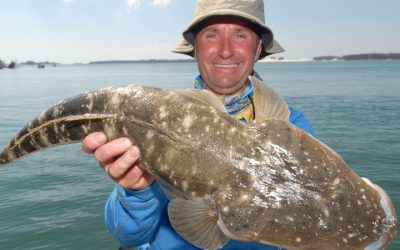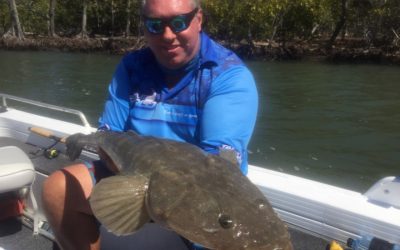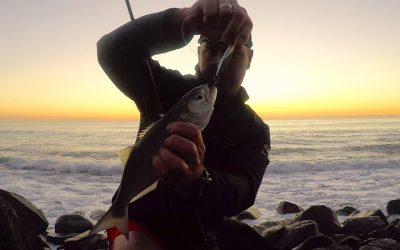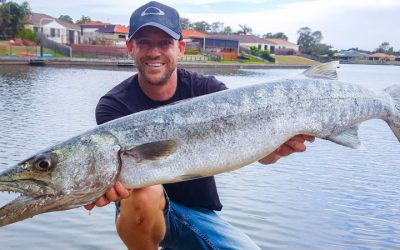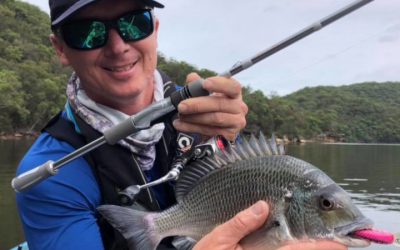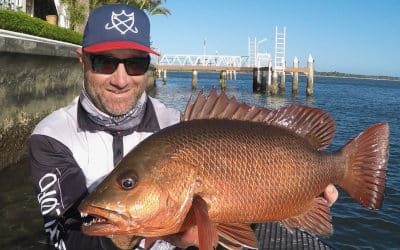Flathead are distributed right across the Gold Coast in good numbers, but spring is the time when the bigger fish become more concentrated and easier to target. Gold Coast sponsored angler Guy McConnell does a great job of sharing tips that will help anyone catch more (and better quality) flathead on lures.
Ultimate Guide To Fishing At The Gold Coast:
25 Fishing Spots For Lure Fishers
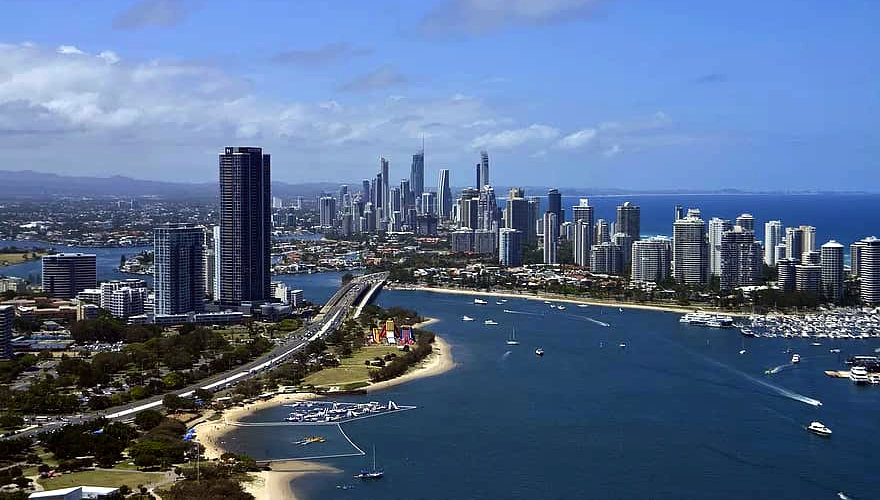
Fishing on the Gold Coast is an angler’s paradise, offering endless opportunities for those looking to reel in a big catch. Whether you’re casting off from the beach, exploring the estuaries, or venturing offshore, the Gold Coast has something for every fishing enthusiast. This guide is crafted for the dedicated fisherman, packed with practical tips and insider knowledge to help you make the most of your time on the water. Get ready to discover the best spots, the right gear, and the techniques that will elevate your fishing game to the next level. Let’s dive in and start catching more fish!
FISHING THE GOLD COAST: TABLE OF CONTENTS
Southern Gold Coast Fishing Spots
Tweed River Mouth | Palm Beach Reef | Terranora Broadwater | Currumbin Creek | Tallebudgera Creek | Hinze Dam | Burleigh Heads
Fishing Surfers Paradise And The Central Gold Coast
Gold Coast Seaway | Nerang River | Marine Stadium (The Spit) | Southport Broadwater | Wavebreak Island | Loders Creek | Ephraim Island | Capri Island Bridge | Runaway Bay | Girung Island
Northern Gold Coast Fishing Spots
Sovereign Island | Paradise Point | Jabiru Island | Coomera River | Tabby Hole | Jumpinpin Bar | Eden Island Junction | Coombabah Creek
Gold Coast Fish Species
Flathead | Bream | Whiting | Jewfish | Snapper | Squid | Mangrove Jack
Podcast Episodes About Gold Coast Fishing
Southern Gold Coast Fishing Spots
Tweed River Mouth
The mouth of the Tweed River system is a hotspot for Gold Coast lure fishing, giving anglers access to productive water from the shore or boat. This area is prone to strong tidal flow and can be battered by large seas at times, so care is needed to stay safe whilst fishing here.
Type of Fishing: Shore, Boat
Best Conditions: Tide changes
Target Species: Tailor, Whiting, Jewfish, Squid
Resources: Tweed Heads Kingfish | Tweed Heads Mangrove Jack | Tweed River Jewfish
- Surface Poppers: Effective for tailor, particularly at dawn and dusk when they feed actively on the surface.
- Soft Plastics: Versatile in smaller sizes for whiting and 5″ plus sizes for jewfish (I like the Pro Lure Fishtail for this), mimicking a variety of prey from worms to small fish.
- Soft Plastic Prawns: Even better than the real thing when targeting Jewfish on runout tides around the new moon.
- Soft Vibes: Good for jewfish in deeper waters, attracting attention through vibrations and erratic movements.
- Summer: Late spring through early autumn is prime for whiting in this area.
- Winter: The cooler months are perfect for tailor and jewfish, particularly late autumn and early winter, when mullet runs cause jewfish to aggregate near river mouths.
- Tide Changes: Both incoming and outgoing tides are productive, with outgoing tides particularly good for jewfish as they prey on fish and prawns swept out by the current.
- Light to Moderate Wind: Creates ideal surface conditions that can enhance baitfish activity and in turn, predator feeding.
- Casting along current lines for tailor and jewfish, where food is naturally concentrated. Fishing the ends of the breakwalls with hard bodies or large soft plastic paddletails during periods of flooding can be especially effective.
- Bottom fishing with weighted soft plastics, soft prawns or soft vibes for jewfish, targeting deeper channels and holes.
- Drifting and casting lures during high tide for whiting along sandy flats and drop-offs. Pay extra attention to areas with broken weed beds interspersed with sandy bottom.
Palm Beach Reef
The reef system off Palm Beach is a popular fishing spot that is generally limited to boat fishers, although some hardy kayakers get onto the water in this area when conditions are suitable. It’s one of those fishing spots on the Gold Coast where anything can turn up from cobia to snapper, sweetlip and tuna. But it’s probably best known as a mackerel hotspot
Type of Fishing: Boat
Best Conditions: Early morning
Target Species: Snapper, Cobia, Spotted Mackerel, Spanish Mackerel
Resources: Palm Beach Mackerel
- Soft Plastics: Effective for snapper; use natural colours and fish them close to the reef structure.
- Jigs: Heavier jigs work well for cobia, using a fast-jigging motion to mimic injured fish.
- Spoons and Trolling Lures: Best for mackerel, as their shiny appearance and rapid movement attract these fast-swimming predators.
- Snapper: Snapper tend to be in close and in shallower waters during the cooler months, from late autumn to early spring (be aware of the closed season that falls in this period). During the warmer months the snapper fishing can be better out wide on the deeper reefs.
- Mackerel: Best targeted from late spring through summer when these species migrate through the area.
- Cobia: Can turn up at any time of year, but are more common from spring through to autumn.
- Bottom Fishing: Use soft plastics and slow pitch jigs for snapper and cobia, focusing on the areas around the reef structure.
- Trolling: Effective for catching mackerel, using spoons or deep-diving lures along the current lines near the reef.
- Fast Jigging: using larger jigs is effective on cobia and will also take mackerel, at times.
Terranora Broadwater
The Terranora Broadwater on Queensland’s Gold Coast offers a serene and productive fishing experience, boasting a mix of sand flats, weed beds, and deeper channels. This idyllic spot is perfect for both shore and kayak fishing, providing ample opportunities to target a variety of species.
Type of Fishing: Boat, Kayak, Shore
Best Conditions: Rising tide
Target Species: Flathead, Whiting, Bream, Trevally
- Soft Plastic Grubs: Versatile for mimicking crustaceans and small fish, these lures are effective for bream and whiting in the clearer waters of the Broadwater.
- Paddletail Soft Plastics: Ideal for targeting flathead, especially when rigged weedless and cast along the edges of sand flats and weed beds.
- Hard-bodied Lures: Pro Lures ST72 for bream and whiting; 90-120mm shallow and deep divers for flathead and trevally.
- Surface Stickbaits and Poppers: Smaller stickbaits are excellent for whiting and bream, while medium sized stickbaits and poppers can target trevally.
- A rising tide enhances access to sand flats and weed beds where predatory fish hunt for food. Ideal fishing times are during rising tides as more areas become accessible to both fish and anglers. Boating anglers need to be careful not to be trapped by a falling tide.
- Calm, sunny days are perfect for visual fishing and using topwater lures, especially earl and late in the day. This is a clearwater system, so a little breeze to ripple the surface can help conceal the angler and embolden the fish during the brighter parts of the day.
- Bottom Fishing: Use soft plastics and slow pitch jigs for snapper and cobia, focusing on the areas around the reef structure.
- Trolling: Effective for catching mackerel, using spoons or deep-diving lures along the current lines near the reef.
- Fast Jigging: using larger jigs is effective on cobia and will also take mackerel, at times.
Currumbin Creek
Currumbin Creek stretches from the beachfront, winding inland through varied habitats including mangrove-lined banks and sandy areas. This diversity of habitat makes it a prime Gold Coast fishing option.
Type of Fishing: Kayak, Shore
Best Conditions: High tide
Target Species: Bream, Flathead, Mangrove Jack
- Crankbaits: Smaller hard bodies are ideal for bream, mimicking small fish and crustaceans in the creek. 75-110mm hard bodies attract plenty of attention from jacks.
- Soft Plastics: Effective for flathead, use shad tails and grub styles that bounce along the bottom.
- Paddle Tail Soft Plastics: Great for mangrove jack, especially around bridge pylons and natural snags.
- General: Best fishing times are during high tides when fish like mangrove jack move closer to shore and into creek channels to feed.
- Summer: Excellent for targeting mangrove jack around snags and pylons as they are more active and aggressive. Flathead also bite well through summer.
- Winter: Bream gather in deeper parts of the creek, while flathead are commonly found along sandy flats warming in the sun.
- Mild to moderate wind is ideal as it stirs up the water, encouraging fish to feed.
- Sunny Days: Best for flathead as they enjoy sunning in shallow waters.
- Structure Fishing: Target mangrove jack by casting close to submerged logs, rock walls, and bridge pylons using paddle tail soft plastics.
- Flats Fishing: Drift over sandy areas during high tide for flathead using soft plastics.
- Edge Fishing: Cast along the mangrove edges during high tides for bream using crankbaits.
Tallebudgera Creek
You’ll be hard-pressed to find a Gold Coast fishing spot with clearer water and a more appealing mix of sandy areas and structured spots with overhanging trees and rock walls. Tallebudgera Creek is a slice of paradise hidden in suburbia
Type of Fishing: Kayak, Shore
Best Conditions: Rising tide
Target Species: Bream, Mangrove Jack
- Soft Plastic Grubs: Versatile for mimicking crustaceans and small fish, effective for bream in shaded areas.
- Paddletail Soft Plastics: Rigged weedless and thrown hard against any kind of structure to tempt mangrove jack.
- Hard-bodied Lures: 75-110mm sizes are ideal for targeting mangrove jack along structures and mangrove edges with aggressive retrieves.
- Surface stickbaits and poppers are deadly on bream in the smaller lure sizes and jacks in medium sizes.
- General: Best fishing during warmer months when mangrove jack are more active.
- Rising Tide enhances access to mangroves and structure where mangrove jack and bream are prevalent.
- Calm, sunny days are ideal for visual fishing and using topwater lures.
- Surface Fishing: Use poppers and walk-the-dog style lures during early morning or late afternoon for aggressive topwater strikes from mangrove jack.
- Jigging grubs is effective along drop-offs and deeper channels for bream using weighted soft plastics.
Hinze Dam
Located in the Gold Coast hinterland, Hinze Dam offers a vast expanse of freshwater with varied habitats including submerged timber, rocky outcrops, and weed beds. The dam’s environment provides excellent opportunities for both boat and shore fishing.
Type of Fishing: Boat (Electric motor only), Kayak, Shore
Best Conditions: Early morning, Late afternoon
Target Species: Australian Bass, Saratoga, Yellowbelly (Golden Perch)
Resources: Hinze Dam Bass
- Spinnerbaits: Effective for Australian bass, especially when fished near submerged timber and rocky areas.
- Surface Lures: Ideal for Saratoga, particularly during low light conditions around weed beds and lily pads.
- Soft Plastics: Versatile for Yellowbelly, use paddle tails and curly tails around submerged structures, rigged weedless.
- Fishing is generally productive throughout the year, with early morning and late afternoon being the best times to target active fish.
- Summer: Excellent for targeting Saratoga with surface lures during dawn and dusk around weed beds and lily pads. Australian bass are also more active, particularly near submerged timber.
- Bass can be caught year-round, but it’s best to focus on fishing deeper during the hotter months and shallower over the cooler months.
- Winter: Yellowbelly are commonly found near rocky outcrops and submerged structures, responding well to slow-moving soft plastics. Australian bass can be targeted in deeper water using spinnerbaits.
- Mild to Moderate Wind: Ideal as it creates ripples on the surface, making fish less wary and more likely to strike.
- Overcast Days: Best for all species, particularly Australian bass, as they are more active and venture into shallower areas.
- Structure Fishing: Target Australian bass and Yellowbelly by casting spinnerbaits and soft plastics close to submerged timber and rocky outcrops.
- Surface Fishing: Focus on Saratoga during low light conditions using surface lures around weed beds and lily pads. Early morning and late afternoon are prime times.
- Deep Water Fishing: In cooler months, target Yellowbelly and Australian bass in deeper water using slow-moving soft plastics and spinnerbaits.
Burleigh Heads
Burleigh Heads offers a diverse coastal environment with sandy beaches, rocky outcrops, and headlands. This variety creates excellent opportunities for shore and rock fishing, attracting a range of species.
Type of Fishing: Shore, Rock
Best Conditions: Incoming tide, early morning and late afternoon
Target Species: Bream, Tailor, Trevally
Resources: Burleigh Heads Tailor
- Metal Slugs: Ideal for tailor, mimicking baitfish and effective when casting from the shore or rocks.
- Soft Plastics: Versatile for bream and trevally, use paddle tails and jerk shads around rock ledges and sandy patches.
- Hardbody Minnows: Effective for all target species, especially when worked along rock walls and ledges.
- General: Best fishing times are during incoming tides, particularly early morning, and late afternoon when fish are more active and feeding closer to shore.
- Winter: The cooler months are definitely the prime times to fish Burleigh Heads. Bream gather in larger numbers, making them easier to target from the shore or around rock ledges. Trevally are also active and can be found around deeper rock pools and ledges. Tailor tend to roam the foamy, washy areas.
- Calm Conditions: Ideal for fishing from the rocks, ensuring safety and better lure presentation.
- Overcast Days: Best for all species, as fish are less wary and more likely to venture closer to shore.
- Rock Fishing: Target tailor and trevally by casting metal slugs and hardbody minnows from rock ledges. Ensure safety by watching the waves and choosing stable fishing spots.
- Beach Fishing: Focus on bream and tailor during incoming tides using soft plastics and hardbody minnows. Cast towards gutters and deeper channels.
- Edge Fishing: Work soft plastics along the edges of rocky outcrops and sandy patches for bream and trevally. Adjust your retrieve speed to match the species’ behaviour.
Central Gold Coast Fishing Spots
Gold Coast Seaway
The Seaway Walls, marking the northern boundary of the Gold Coast Broadwater, are known for strong tidal flows and deep water close to shore, creating ideal conditions for several large species.
Type of Fishing: Shore, Boat
Best Conditions: Night, high tide
Target Species: Jewfish, Tailor, Trevally
Relevant Resources: Seaway snapper | Seaway Tailor | Seaway jewfish
- Large Soft Plastic Paddletails: Effective for jewfish, mimicking the movement of baitfish in the water.
- Metal Jigs: Suitable for deeper water jigging, particularly attractive to tailor and trevally.
- Surface Lures: Excellent for early morning or late evening sessions, appealing to active tailor and trevally feeding on the surface.
- Wet Season: Fishing can be productive, especially in the leadup to new and full moons, fishing on the tide turns. Anything can turn up in the seaway at these times.
- Dry Season: Jewfish tend to move closer to structure and deeper areas, trevally and tailor feed aggressively in the washy areas.
- High Tide: Enhances fishing potential by bringing fish closer to the wall and into shallower water accessible from shore or kayak.
- Clear Nights: Ideal for targeting jewfish with soft plastics mimicking squid or large baitfish.
- Windy Conditions: Can stir up baitfish, making metal jigs and surface lures more effective as they create more disturbance.
- Vertical Jigging: Effective in targeting jewfish and trevally, using quick jerks to simulate fleeing fish.
- Cast and Retrieve: Best for tailor, casting parallel to the wall and retrieving quickly to provoke strikes.
Nerang River
The Nerang River flows through diverse environments from the hinterland to the sea, featuring extensive mangrove areas, rock walls, and man-made structures such as jetties and bridges. These structures provide excellent shelter and feeding grounds for the target species.
Type of Fishing: Boat, Kayak, Shore
Best Conditions: Incoming tide
Target Species: Mangrove Jack, Bream
Relevant Resources: Mangrove Jack 1 | Mangrove Jack 2 | Mangrove Jack 3
- Paddle Tail Soft Plastics: Ideal for mimicking small fish and prawns, effective for both mangrove jack and bream in murky or shaded waters.
- Crankbaits: Best suited for targeting bream around structures, offering vibration and noise to attract attention in deeper or turbulent waters.
- Soft Plastic Prawns: Perfect for rigging weedless and fishing in structure. Especially useful on bigger tides around new moon periods.
- Small metal blades can be worked quickly, hopped and stopped or teabagged vertically for bream.
- Incoming Tide: This is when the river’s flow brings in clean, salty water, which can stimulate fish activity, making it an optimal time for fishing.
- Summer: Higher chances of encountering aggressive mangrove jack as they are more active in warmer temperatures.
- Winter: Bream tend to aggregate around deeper structures, making them easier to target with crankbaits.
- Light Rain: Can enhance fishing conditions by increasing cloudiness in the water, drawing fish closer to the surface and shorelines. Too much rain can shut down the bite.
- Casting Along Structures: Effective for reaching mangrove jack that prefer the cover of overhanging trees or submerged logs. Use EWG hooks and weedless rigged soft plastics for this.
- Vertical Jigging: Works well around deep structures like bridge pylons for bream.
Marine Stadium (The Spit)
Located near the northern end of The Spit on the Gold Coast, Marine Stadium offers a prime fishing location with a unique mix of deep channels, sandy bottoms, and structured spots such as rock walls and jetties. Known for its calm waters and excellent accessibility, Marine Stadium is a hidden gem for lure fishing enthusiasts.
Type of Fishing: Boat, Kayak, Shore
Best Conditions: Night-time or early morning
Target Species: Squid, Bream, Flathead, Trevally
- Squid Jigs: Brightly coloured jigs in sizes 2.5 to 3.5 are effective for targeting squid, especially around well-lit areas.
- Soft Plastic Paddletails: Versatile for mimicking small fish, great for targeting flathead and trevally along sandy bottoms and structure.
- Vibes and Blade Lures: Ideal for deeper channels where bream and trevally are prevalent. These lures provide vibration and flash to attract predatory fish.
- Surface Lures: Small poppers and stickbaits are effective for bream, especially in the early morning or late evening.
- General: The best fishing at Marine Stadium typically occurs during the warmer months when fish are more active. Squid can be targeted year-round, but are most prolific during spring and autumn.
- Rising Tide: Enhances access to deeper channels and structure where flathead and bream are often found.
- Calm, Clear Nights: Ideal for squid fishing, as squid are attracted to light and clear water conditions are preferable for visual fishing.
- Squid Fishing: Utilize bright, glowing squid jigs and focus on areas around artificial lights such as piers and jetties during the night.
- Soft Plastics: Cast and retrieve soft plastics along the sandy bottoms and structure for flathead. Use a hopping motion to mimic injured baitfish.
- Vibes and Blades: These lures are effective when jigged vertically in deeper channels. The vibration and flash attract bream and trevally.
- Surface Fishing: Target bream with small poppers and stickbaits during low light conditions. Walk-the-dog retrieves can provoke aggressive strikes.
Southport Broadwater
The Southport Broadwater is Gold Coast Fishing at its finest. The Broadwater offers a unique blend of sheltered waters and rich marine ecosystems, making it ideal for both novice and experienced anglers. Its accessibility from multiple points along the shore and by boat enhances its appeal.
Type of Fishing: Shore, Boat, Kayak
Best Conditions: All tides
Target Species: Flathead, Whiting, Bream, Squid
Relevant Resources: Broadwater Squid
- Soft Plastics: Versatile and effective for all target species, mimicking a variety of prey such as prawns and small fish.
- Grubs: Ideal for attracting bream with their tantalising movements, especially when lightly weighted and worked with gentle “hop and drop” techniques.
- Squid jigs: smaller sizes (1.5-2.5) in a range of weights and colours are effective.
- The area’s diverse habitat and sheltered waters support year-round fishing opportunities.
- Best Tides: While fishable at all tides, the last two hours of an outgoing tide can be particularly productive for flathead as they feed on prey being washed out of estuaries and creeks.
- Light winds: Ideal for light tackle fishing; allows for wind assisted casting and stealthy approaches.
- Bottom Fishing with Jigs: Effective for flathead, particularly along sandy bottoms where they camouflage.
- Drift Fishing: Excellent for covering larger areas when targeting whiting; keeps the stickbaits or soft plastics moving enticingly through feeding zones.
- Spot Fishing from Shore: Cast towards structure or drop-offs where bream are likely to congregate.
Wave Break Island
Wave Break Island is situated in the Broadwater, known for its calm waters and protective environment that shields from rougher seas. One of the Gold Coast’s favourite fishing spots, Wavebreak boasts rich aquatic structures such as submerged rocks, sandbanks, and seagrass beds, which provide excellent habitats for a variety of species.
Type of Fishing: Boat, Kayak
Best Conditions: Incoming tide
Target Species: Bream, Trevally, Flathead, Jewfish
- Soft Plastics: Effective for all target species, especially when matched with the size and type of local baitfish.
- Paddletails and prawns in various sizes are very effective when fished lightly weighted.
- Small Poppers: Ideal for surface feeding trevally and bream during active feeding times.
- Summer: Excellent for flathead, which are more active in warmer waters.
- Winter: Good for jewfish and trevally, which tend to move into shallower waters within the island’s shelter.
- Bream can be targeted year-round, but tend to frequent the shallow shorelines over summer, especially when high tides concur with daw and dusk periods.
- Incoming Tide: Brings in cleaner, nutrient-rich water, enhancing fish activity around the island.
- Weather: Light to moderate winds are preferable, as they do not disturb the water too much yet provide enough movement to keep fish active.
- Hopping and dropping with soft plastics near the bottom can attract flathead and jewfish.
- Surface Popping for trevally and bream early in the morning or late in the evening.
- Drift Fishing along the edge of sandbanks during tide changes maximizes coverage of different depths and habitats.
Loders Creek
Loders Creek offers a family-friendly Gold Coast fishing spot with easy shore access, making it a popular area for casual outings. The creek features a mix of sandy bottoms and vegetated areas that attract diverse species.
Type of Fishing: Shore, kayak
Best Conditions: High tide
Target Species: Flathead, Whiting, Bream
- Soft Plastics: Effective for mimicking small fish and crustaceans, ideal for flathead and bream.
- Small grubs are great for bream, medium to large paddletails are the better option for flathead.
- Light Hard Bodies: Work well for whiting and bream, especially those that mimic small baitfish with a tight wobble.
- High Tide: Fish move closer to shore, increasing catch rates.
- Summer: Best for flathead as they feed aggressively in warmer waters. Whiting are also more active during the warmer months, usually from October through until March
- Winter: Prime time for bream, although flathead can also be caught, especially when fishing shallow banks during sunny afternoons.
- Casting Along Edges: Target the edges of the creek where water movement brings food, attracting fish.
- Slow Retrieve: Effective for both soft plastics and hard bodies, mimicking the natural movement of prey. Keep it moving for whiting, introduce occasional pauses for flathead.
Ephraim Island
Ephraim Island, set amidst high-end residential developments, features a network of canals lined with jetties and pontoons. This environment is conducive to sheltered fishing, offering clear waters and minimal currents, ideal for targeting species like bream and flathead.
Type of Fishing: Boat, kayak
Best Conditions: Incoming tide
Target Species: Bream, Flathead
Relevant Resources: Gold Coast Canal Bream Fishing
- Soft Plastics: Opt for grub or worm styles that mimic small baitfish or crustaceans, perfect for tempting bream and flathead in shallow waters.
- Soft plastic prawns: deadly for bream in smaller sizes or bounced off the bottom in larger sizes for flathead
- Surface Lures: Use small poppers or walk-the-dog style lures to attract bream feeding on the surface, especially near structures.
- Tidal Influence: The incoming tide brings in cleaner, saltier water, which enhances fish activity around the island’s structures. This is the prime time to deploy lures.
- Structural Hotspots: Focus on areas around pontoons and under jetties where bream tend to hide. Flathead often lie on sandy bottoms close to drop-offs and are more active during tide changes.
- Soft Plastic Rigging: Use a light jig head to keep your lure close to the underwater structures without snagging.
- Surface Lure Tactics: Early morning or late afternoon are the best times to use surface lures when bream are more likely to feed on the surface.
Capri Island Bridge
Capri on Via Roma is situated in the heart of the Gold Coast, featuring access to fishing spots from both shore and boat. This spot is known for its deep water and strong tidal flows, which are conducive to attracting larger fish species.
Type of Fishing: Boat, Shore, kayak
Best Conditions: Early morning, Late afternoon
Target Species: Jewfish, Bream, Mangrove Jack
- Soft Plastics: small grubs and ecoprawns are Ideal for bream, mimicking small fish and crustaceans.
- Soft plastic prawns and paddletails are prefect for mangrove jack and jewfish
- Soft vibes in the 70-100m, 20g sizes can be deadly either teabagged or gently hopped along the bottom.
- Best Times: Early mornings and late afternoons are peak times for activity, taking advantage of lower light conditions which larger fish prefer.
- Tidal Influence: Strong tidal flows here enhance fishing opportunities by bringing in fresh bait and stirring up bottom dwellers.
- Weather: Favourable conditions include overcast skies which can extend optimal fishing times beyond early morning and late afternoon.
- Casting soft plastics and working them close to structure can yield good results for all species, particularly around structured areas like jetties and submerged objects.
- Hopping soft plastic paddletails or soft vibes along the bottom can be effective on jewfish at times.
Runaway Bay
Runaway Bay is nestled between the bustling northern Gold Coast and the tranquil waters of the Broadwater. It boasts a variety of fishing environments, from sheltered canals to expansive natural waterways. This diversity makes it a prime Gold Coast fishing spot for both boat and kayak anglers.
Type of Fishing: Kayak, Boat
Best Conditions: Early morning
Target Species: Bream, Flathead, Mangrove Jack
Relevant Resources: Gold Coast Canal Bream Fishing
- Soft Plastics: Ideal for flathead and mangrove jack, mimicking small fish and crustaceans.
- Crankbaits: Effective for bream, especially those that mimic the erratic movement of baitfish.
- Summer: Best for mangrove jack in the canals, as they are more active in warmer conditions.
- Winter: Ideal for bream, which are attracted to the deeper, cooler waters of the bay.
- All Seasons: Flathead are consistently present, but peak during the spring spawn.
- Light Winds: Favourable for kayak fishing as they allow for stable conditions and clearer waters.
- Bottom Fishing: Effective for flathead using soft plastics that bounce along the seabed.
- Structure Fishing: Cast near submerged logs, rock walls, or jetty pylons with crankbaits for bream and mangrove jack.
Girung Island
Girung Island, nestled in a quieter part of the Gold Coast waterways, is surrounded by extensive mangrove forests. These natural structures provide an excellent habitat for a variety of estuarine species.
Type of Fishing: Boat
Best Conditions: Outgoing tide
Target Species: Mangrove Jack, Bream, Flathead
- Poppers: Effective for enticing Mangrove Jack on the surface, especially near overhanging mangrove branches.
- Soft Plastics: Suitable for targeting Bream hiding under mangrove roots or along the muddy banks.
- Soft Plastic Paddletails: Perfect fished weedless for mangrove jack close to cover or for flathead on a regular jighead
- Bent Minnows and stickbaits: Fish over flats along drop-offs for flathead
- The outgoing tide is particularly effective at Girung Island, as it draws baitfish and other prey from the mangroves, making predators like Mangrove Jack and Bream more active and accessible.
- Warmer Months: Optimal for Mangrove Jack as they become more aggressive and are likely to strike at surface lures like poppers.
- Colder Months: Bream tend to gather in deeper, sheltered waters around the island, responding well to jigged soft plastics.
- Surface Popping: Cast poppers close to mangrove edges during early morning or late afternoon for the best action.
- Hop n Drop Soft Plastics: Effective for reaching Bream in deeper water or under mangrove canopies during low tides.
Northern Gold Coast Fishing Spots
Sovereign Island
Sovereign Island is known for its luxurious waterways and extensive canal systems, offering excellent structure fishing. The environment includes docks, pontoons, and submerged structures, making it a haven for species that thrive around man-made features.
Type of Fishing: Boat, Kayak
Best Conditions: All tides
Target Species: Mangrove Jack, Trevally, Bream
Relevant Resources: Gold Coast Canal Bream Fishing
- Crankbaits: Effective for exploring various depths and structures, enticing bream (smaller lures) and trevally (medium sized lures).
- Soft Plastics: Versatile for targeting mangrove jack in and around structure, mimicking small fish or crustaceans.
- Optimal Fishing Times: While fishing can be productive at all tides, the high tide often brings the best results as more areas become accessible and fish move closer to shorelines and structures.
- Seasonal Behaviour: Mangrove jack are particularly active during the warmer months, while trevally can be targeted year-round. Bream tends to increase in activity during the cooler months.
- Weather Influence: Lighter winds allow for better boat control and more precise lure placement. Overcast conditions can also increase fish activity near structures.
- Casting Close to Structures: Ideal for mangrove jack, using soft plastics to probe around jetties, under pontoons, and beside boat hulls.
- Using Crankbaits: Effective for covering a larger area when searching for trevally and bream, especially along canal edges where these fish patrol for food.
Paradise Point
Paradise Point boasts numerous parks and family-friendly areas, providing easy shoreline access for both shore-based and kayak anglers. Its calm waters and abundant vegetation make it a prime Gold Coast fishing location for diverse species.
Type of Fishing: Shore, Kayak
Best Conditions: All tides
Target Species: Bream, Whiting, Flathead
Relevant Resources: Gold Coast Canal Bream Fishing
- Soft Plastics: Effective for flathead, imitating small fish and crustaceans. Use grub or worm styles for bream and whiting.
- Light Spinners: Attract bream and whiting with their reflective spin and vibration, especially effective in clear water.
- Tides: Productive fishing can be experienced at all tide levels. High tides allow deeper access to estuaries and mangroves, while low tides can expose structure where fish may lurk.
- Summer: Early morning or late evening are best to avoid the heat and recreational water traffic. Target flathead along sandy bottoms.
- Winter: Bream tend to move into deeper, warmer waters. Focus on deeper drops and channels.
- Spring/Autumn: Transition periods can bring active feeding as water temperatures change, making it a great time for targeting all three species with varied techniques.
- Wind: Light to moderate winds are ideal. Strong winds can make kayak fishing challenging and may stir up sediment, reducing water clarity.
- Rain: Light rain can improve fishing conditions by washing insects and organic material into the water, but heavy rain might decrease salinity and push fish out to deeper water.
- Casting Close to Structures: Ideal for mangrove jack, using soft plastics to probe around jetties, under pontoons, and beside boat hulls.
- Using Crankbaits: Effective for covering a larger area when searching for trevally and bream, especially along canal edges where these fish patrol for food.
Jabiru Island
Jabiru Island is renowned for its lush parkland and easy access, making it a favourite spot for family-friendly fishing and kayakers. The island’s banks are lined with spots that are ideal for casting from both shore and kayak.
Type of Fishing: Shore, Kayak
Best Conditions: Early morning, High tide
Target Species: Bream, Flathead
- Crankbaits: Effective for bream, mimicking small fish and crustaceans.
- Soft Plastics: Versatile for flathead, especially paddletails when worked along the bottom or near structure.
- Early Morning: The best time to target both bream and flathead as they feed actively.
- High Tide: Enhances accessibility to deeper parts along the banks where bigger fish like to feed.
- Tide Influence: High tide provides the best conditions for targeting deeper areas along the banks, increasing chances of encountering flathead.
- Seasonal Movements: During warmer months, flathead become more aggressive, making soft plastics particularly effective.
- Bottom Fishing with Soft Plastics: Dragging or jigging soft plastics along the bottom can be particularly productive for flathead.
- Casting Crankbaits for Bream: Utilizing light tackle with small to medium crankbaits around submerged structures or vegetated areas.
Coomera River
The Coomera River, with its extensive mangrove systems and complex waterways, provides a rich habitat for a variety of fish species. The lower reaches are particularly known for flathead, especially in sandy and muddy areas near the river mouth.
Type of Fishing: Kayak, Boat
Best Conditions: Outgoing tide
Target Species: Mangrove Jack, Flathead
Relevant Resources: Gold Coast Canal Bream Fishing | Mangrove Jack 1 | Mangrove Jack 2 | Mangrove Jack 3
- Diving Lures: Effective for reaching deeper spots where mangrove jack hide.
- Soft Plastics: Ideal for both mangrove jack and flathead, mimicking the vibrations of small prey fish.
- Surface Lures: Great for mangrove jack during low light periods or flathead at any time, especially on overcast days
- Outgoing Tide: The best time for targeting flathead as they lie in wait in the deeper channels to ambush prey being washed out with the tide.
- Summer and Spring: Peak seasons for mangrove jack, which are more active in warmer temperatures.
- Wind and Weather: Light to moderate winds are ideal, as heavy winds can stir up sediment and decrease water clarity, making fishing challenging.
- Trolling along the edges of mangrove lines or deeper channels can be effective for locating actively feeding fish.
- Casting to snags and drop-offs with diving lures or soft plastic paddletails, particularly in areas with submerged logs or rock structures where mangrove jack often reside.
- Working topwater around natural structure for jacks, or drop-offs and weed beds for flathead.
- Surface Poppers and small stickbaits: Effective for whiting in shallow waters during the warmer months, mimicking small prawns on the surface.
- Paddletail Soft Plastics: Ideal for flathead, especially when used near sandy bottoms to mimic small fish or crustaceans.
- Spring and Summer: Best times for whiting, as they are more active and feed aggressively in warmer waters, especially around the new moon.
- Autumn and Winter: Flathead become more prevalent and larger, particularly near sandbanks during incoming tides.
- Clear, Calm Days: Ideal for using surface poppers and light jigs, as fish are more likely to feed in visible, shallow waters.
- Topwater Fishing: Effective in clear water conditions; watch for fish movements and cast ahead of the school or simply fan out casts to cover water, especially near small drains and dropoffs.
- Casting: Use lightly weighted paddletail soft plastics to bounce along the sandy bottom, attracting flathead lurking below.
Jumpinpin Bar
- Soft Plastic Paddletails: Effective for flathead, mimicking local baitfish.
- Minnow Lures: Good for bream and tailor, offering quick darting action.
- Metal Spoons: Best for tailor during feeding frenzies, reflecting the flash of small fish.
- Surface Poppers: Useful for targeting tailor feeding on the surface at dawn or dusk.
- Summer: Prime for tailor near shores and flathead in sandy channels.
- Winter: Bream in deeper waters; flathead larger and more active.
- Run-out Tide: Ideal for ambush predators like flathead in outgoing channels.
- Mild Wind & Rain: Light wind is favourable; moderate rain can stimulate feeding but avoid heavy downpours.
- Drifting in deep channels targets flathead.
- Casting to Structure for bream hiding near features.
- Trolling for tailor with deep-diving lures in channels.
Eden Island Junction
Eden Island Junction is known for its strong and dynamic water flows where several channels converge, creating an ideal environment for large, predatory fish. This area is particularly noted for its structural features that provide excellent hiding spots for fish.
Type of Fishing: Boat
Best Conditions: All tides
Target Species: Trevally, Jewfish
- Metal Jigs: Highly effective for both trevally and jewfish, mimicking the erratic movement of small baitfish.
- Soft Plastic Prawns Rigged on standard J hook jig heads and hopped over drop-offs and through deeper holes and channels.
- Poppers and stickbaits: Effective on trevally around dawn and dusk when they are often surface feeding.
- Tidal Influence: Although fishing can be productive at all tides, the changing water levels during tide shifts can significantly enhance your chances as they stimulate fish activity.
- Seasonal Behaviour:
- Warmer Months: Jewfish are more active and can be found closer to the surface during early morning or late evening.
- Cooler Months: Trevally become more aggressive, providing thrilling fishing experiences, especially when using metal jigs.
- Jigging: Effective for both species, where rapid vertical movements near structural drop-offs can provoke strikes. Slow pitch jigging can also be effective.
- Poppers: cast around pressure points, flats and structures, especially where fish, bait or birds can be seen working.
Coombabah Creek
Coombabah Creek is an excellent fishing spot on the northern Gold Coast, offering a mix of calm waters, mangrove-lined banks, and sandy bottoms. This area is perfect for targeting various species, including squid, due to its diverse habitat and accessible fishing locations.
Type of Fishing: Kayak, Shore, Boat
Best Conditions: Rising tide, night for squid
Target Species: Squid, Bream, Flathead, Mangrove Jack, Trevally
Relevant Resources: Gold Coast Canal Bream Fishing | Mangrove Jack 1 | Mangrove Jack 2 | Mangrove Jack 3
- Squid Jigs: Use brightly colored jigs in sizes 2.5 to 3.5. Squid are attracted to lights, so fishing around lit areas or using a squid light can be effective.
- Soft Plastic Grubs: Great for bream and flathead, especially when fishing around mangroves and sandy areas. A slow, hopping retrieve works best.
- Paddletail Soft Plastics: Effective for trevally and flathead. Rig them weedless for fishing around structure.
- Hard-bodied Lures: Small to medium-sized lures are ideal for targeting bream and trevally. Use a steady retrieve near structure.
- Surface Lures: Poppers and stickbaits are effective for bream and mangrove jack, particularly during low light conditions.
- General: The best fishing at Coombabah Creek occurs during the warmer months when most species are more active. Squid fishing is good year-round, with peaks in spring and autumn.
- Rising Tide: This tide phase enhances access to mangroves and structured areas where fish like to feed.
- Calm, Clear Nights: Ideal for squid fishing, as they are attracted to light and prefer clear water conditions.
- Squid Fishing: Focus on areas with artificial light such as jetties and piers if fishing at night. Squidding can be very effective during the daytime as well. A slow, jerky retrieve works best with prawn style jigs.
- Soft Plastics: Cast and retrieve soft plastics along the sandy bottoms and around structure for flathead and bream. Use a hopping motion to mimic injured baitfish or crustaceans.
- Surface Fishing: Target bream and mangrove jack with poppers and stickbaits during low light conditions. Walk-the-dog retrieves can provoke aggressive strikes.
Key Spots at Coombabah Creek:
- Mangrove Edges: Provide shelter and food sources for bream and mangrove jack.
- Deep Channels: Good for targeting flathead and trevally, especially during rising tides.
- Lit Areas at Night: Perfect for squid fishing, as squid are drawn to light and tend to congregate around well-lit structures.
Gold Coast Fishing By Species And Season
Flathead
Flathead are a staple target for Gold Coast fishing enthusiasts, particularly the dusky flathead. These ambush predators are most active during the warmer months, from September to April, when they move into the shallows to feed and spawn. During this period, flathead can be found in estuaries, river mouths, and sandy flats.
Seasonal Behaviour
- Spring and Summer: Flathead move into shallower waters, making them accessible to land-based anglers.
- Autumn and Winter: While less active, flathead still feed and can be caught in deeper channels and around structure.
Best Lures
- Soft Plastics: Grub and paddle-tail styles are highly effective.
- Hard-bodied Lures: Suspending and diving lures that mimic baitfish work well.
For more detailed tips on lure fishing for flathead, check out our Flathead Fishing Episodes.
Bream
Bream are another popular species, offering year-round fishing opportunities. These fish are particularly prevalent in the cooler months, from May to August, when they aggregate in large numbers for spawning. During this time, they are often found in deeper water of the estuaries, around rock walls, and under jetties. Through the warmer months bream can often be taken on the flats and shallow reefs where they hit surface stickbaits, soft prawns and paddletail grubs.
Seasonal Behaviour
- Winter: Peak season for bream, with large schools forming.
- Spring and Summer: Bream spread out and can be found in mangroves, around structures, and in deeper holes.
Best Lures
- Soft Plastics: Small grubs and creature baits.
- Hard-bodied Lures: Small crankbaits and minnows.
For more insights on bream fishing with lures, explore our Bream Fishing Archive.
Whiting
Whiting, especially the sand whiting, are highly sought after and are a genuine Gold Coast lure fishing target. They are most active during the warmer months, from November to April and can often be caught on topwater lures such as small stickbaits around the new moons when the prawns are moving.
Seasonal Behaviour
- Spring and Summer: Whiting move into shallow sand flats and estuaries to feed on worms and small crustaceans.
- Autumn and Winter: Whiting can still be caught but tend to be less active and found in slightly deeper waters.
Best Lures
- Surface Lures: Small poppers and stickbaits.
- Soft Plastics: Worm imitations and small minnows.
For tips on targeting whiting, visit the ALF Podcast Whiting Collection.
Jewfish (Mulloway)
Jewfish, also known as mulloway, are a prized catch for their size and challenge. They are more active at night and during the cooler months, from April to August.
Seasonal Behaviour
- Winter: Prime time for jewfish, often found in deeper holes and channels, can distribute right through the river system during low rainfall months.
- Spring and Autumn: Often found around estuary mouths and rock walls, especially during the annual mullet runs in April/May and after floods at any time of year.
- Summer: Less prevalent but still catchable. Mulloway in the warmer wetter months tend to be found around eddies and pressure points in the lower parts of the system where tides bring regular flushes of clean seawater.
Best Lures
- Soft Plastics: Large paddle-tails and jerk shads.
- Vibes and Jigs: Effective in deeper water.
For more on jewfish, check out our Jewfish Interviews.
Snapper
Snapper are a versatile species, found both inshore and offshore. They can be targeted all year round, but the locations you’ll find them and the techniques you’ll need to use vary from season to season.
Seasonal Behaviour
- Summer (December to February): Found inshore in estuaries and bays, feeding actively.
- Autumn (March to May): Transition between inshore and offshore, found around both shallow and deeper waters.
- Winter (June to August): Move offshore to deeper reefs for spawning, particularly in July and August.
- Spring (September to November): Return inshore following baitfish and prey, present in both inshore and offshore areas.
Best Lures
- Soft Plastics: Curly tails and paddle-tails.
- Jigs: Slow-pitch and micro jigs.
For more snapper fishing techniques, check out our Snapper Fishing collection.
Squid
Squid are a fun and challenging target, especially during the cooler months. They are often found in shallow weed beds, rocky foreshores and around jetties. Fishing near lighted areas at night is also a popular way to target squid.
Seasonal Behaviour
- Autumn and Winter: Peak season for squid, as they move into shallower waters to spawn.
- Spring and Summer: Squid can still be caught but are less concentrated.
Best Lures
- Squid Jigs: Various colors and sizes, with natural and bright patterns.
For more on catching squid, check out our squid fishing collection.
Mangrove Jack
Mangrove jack are aggressive predators found in estuaries, bays, canals and rivers. Despite their name, they’re not limited to just mangrove habitat, but also lurk around pontoons, rock walls, bridge pylons and other hard structure. They are most active during the warmer months, from October to March.
Seasonal Behaviour
- Spring and Summer: Jacks are highly active, moving into shallow mangroves and snags.
- Autumn and Winter: They can still be caught but are less aggressive and often found in deeper holes.
Best Lures
- Hard-bodied Lures: Deep-diving crankbaits and suspending lures.
- Soft Plastics: Paddle-tails and creature baits.
For comprehensive tips on catching mangrove jack, check out our mangrove jack fishing collection.
ALF Episodes About Fishing At The Gold Coast
Episode 567: Gold Coast Flathead with Ryan Vines
Ryan is a lifelong Gold Coast Fishing fanatic and winner of the 2022 Flathead Classic. His business Capn’s Charters specialises in lure fishing for flathead, among other species, on the northern Gold Coast.
Discover the Best Fishing Spots in Southeast Queensland this Spring
For the boating angler, Southeast Queensland during spring is all about big snapper, quality jewfish, threadfin salmon, flathead and plenty more! Nabeel Issa is a multiple time ALF podcast guest and always has plenty of great info to share. Today he walks us through why spring is his favourite time to fish in SEQ and gives us the rundown on how, when and where.
Episode 532: Top Brisbane Landbased Fishing Spots In Winter With Beau Rixon
Brisbane offers an astonishing range of land based fishing options to suit anglers of all skill levels, ranging from the hunble flathead right through to tailor, squid, bass and jewfish. Local fishing tutor and land-based guide Beau Rixon spends a lot of time fishing the area from the shore and teaching others to do the same, so for today’s episode I invited Bea to jump onboard and share some of his favourite land based spots.
Episode 481: Gold Coast Mangrove Jack With Owen McPaul
The Gold Coast area is famous for stonking, horse jacks, and today’s guest Owen McPaul catches his share of trophies!
Episode 429: Gold Coast Mangrove Jack With Alex Watson
Spring is when mangrove jacks on the Gold Coast pontoons start coming to life and today’s guest Alex Watson sure knows how to catch them!
Episode 400: Gold Coast Snapper With Will Kitching
The shallow inshore reef systems along Queenslands southern coastline are prime areas to target snapper on lures, says Will Kitching
Episode 339: SE Queensland Giant Herring With Beau Rixon
Giant herring are an awesome sportfishing target and are more available around SE Queensland than most angler realise. Beau Rixon shares his tips for giant herring fishing in Episode 339.
Episode 280: Hinze Dam Bass With Kane Rowsell
Hinze Dam holds plenty of quality bass, and if you can find them they are usually quite agressive. That’s if you can find them. Luckily Hinze specialist Kane Rowsell helps out in Episode 280 of the ALF podcast.
Episode 262: Gold Coast Spotted Mackerel With Brad Smith
Brad’s Top Spotted...
Episode 261: SE Queensland Skinny Water Bass With John Costello
Fishing for wild bass in the rivers and creeks of SE Queensland can be rewarding and therapeutic……. but it can also be exhilarating. With bass season 2020 about to open, local fishing gun John Costello from “My Lure Box” takes us off in search of this exciting little sportfish in the skinny water.
Episode 232: Gold Coast Canal Bream With Stephen Maas
The seemingly endless canals of the Gold Coast are a fertile bream fishing ground. Local tournament angler Stephen Maas shares a few of the tips that have put him on the podium during bream comps.
Episode 198: Gold Coast Mangrove Jack With Shaggy Seghers
The Gold Coast is famous for turning out some amazing mangrove jack fishing and Shaggy Seghers has made a fine art of catching them. In this episode we get some great tips for fishing the southern estuaries of the Gold Coast for the tenacious red dogs.
How To Catch A Mangrove Jack On Lures With John Costello
Fishing for mangrove jacks on Queensland’s Gold Coast is white knuckle, nail biting stuff, but local fishing identity John Costello knows more than just a few secrets for taming the red dogs!
Episode 133: SEQ Whiting With Brad Smith
Serial podcast guest Brad Smith shares his tips for catching SE Queensland and Northern NSW whiting on surface lures on the flats.
Episode 118: Gold Coast Flathead Fishing With Rob Payne
The Gold Coast Flathead Classic is an iconic fishing event held each year in early October. Fishing journo and Gold Coast resident Rob Payne shares some tips to give you an edge in this awesome competition.
Episode 106: Gold Coast Flathead With Dougie Burt
Gold Coast fishing personality and flathead guru Dougie Burt shares some secrets for flathead fishing on the coast during spring.
Episode 105: Gold Coast Tailor With Paul Burt
Tailor fishing from the rocks is a year-round option on the Gold Coast, and for Paul Burt it’s right in his back yard! We go through the tackle and the techniques for getting onto a school of greenbacks.
Episode 86: Gold Coast Land-based Sport Fishing With Andy Sparnon
The Gold Coast is littered with land-based options for targeting species such as GT’s, queenfish and mangrove jack – even milkfish and barracuda are on offer if you know where to look. Local resident Andy Sparnon from Coast Fish TV gives us some pointers for getting started in this incredible fishery.
Episode 84: Gold Coast Flathead Fishing With John Costello
John Costello is a well known Gold Coast fishing personality who has fished the area for many years. Over the past 12 months he’s started to perfect the art of extra large flathead on surface lures and in this episode explains how he goes about it.
Episode 82: Northern NSW and SEQ Estuary Jewfish with Brad Smith
Brad “Smithy” Smith is a long-time Gold Coast fishing guide with 25 years experience targeting jewfish on lures in the estuaries of northern NSW and southern Queensland. In this episode Smithy share two little know but deadly techniques he’s developed for targeting this awesome sport fish.
Episode 67: Gold Coast Bream With Steve Morgan
Gold Coast bream fishing in the winter months can be very productive, as tournament guru Steve Morgan explains. Finding aggregations of fish in deeper water is the key, so listen to this episode to learn exactly how to go about it.
Episode 45: Gold Coast Flathead With David “Greeny” Green
The Gold Coast is an exceptional flathead fishing destination, as multiple Flathead Classic winner David “Greeny” Green explains. We go through the tackle, the techniques and the lures that will put you on the road to success.
Episode 43: Gold Coast Snapper With Nabeel Issa
Nabeel Issa catches more than his fair share of snapper on South East Queensland’s Gold Coast. In this episode he explains his strategies for catching this awesome sports fish on lures.
Episode 26: Tweed River Mangrove Jack With Brad Smith
The Tweed river offers exceptional fishing for oversized mangrove jacks, and who better to tell us how to catch them than Brad Smith? Brad’s been guiding clients to catch jacks and other species in this area for 25 years and proves he’s a wealth of knowledge.
Episode 18: Nerang River Mangrove Jack With Mick Horn
Mangrove Jack are legendary for their speed, power and aggressive nature. Gold Coast jack guru Mick Horn shares his secrets for targeting this tough sporting species.










